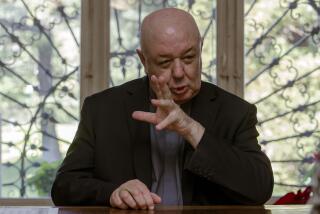Holocaust Archives Generate Interest
- Share via
Hitler’s Luftwaffe leader boasts in a letter about the fine art collection he has amassed from Nazi victims. A Swiss bank lists $29 million in bank accounts owned by Jews who may have perished in the Holocaust. An intelligence document confirms the Nazis’ practice of assigning harder labor to concentration-camp prisoners with “a conspicuous amount of dental gold.”
Such revelations contained in wartime documents at the National Archives repository in College Park, Md., many of them recently declassified, have spawned an extraordinary burst of activity at the 4-year-old facility by researchers, historians and politicians.
“It’s a boom time for Holocaust researchers,” said legal researcher Miriam Kleiman. “Everyone’s out there, looking through boxes.”
Two years ago, when the World Jewish Congress, U.S. officials and the Senate Banking Committee, chaired by Sen. Alfonse M. D’Amato, R-N.Y., probed the role of Swiss banks and other “neutral” countries during the war, much of their evidence was drawn from the Archives’ 15 million pages relating to Holocaust-era assets.
The highly publicized findings shed new light on the complicity of Switzerland, whose secretive links with the Nazis included gold laundering, weapon transportation and restriction of Jewish refugees. Other neutral countries, such as Sweden, Argentina, Portugal, Spain and even the Vatican, were also implicated for their shadowy dealings with the Third Reich.
Now, with the creation of the U.S. Holocaust Assets Presidential Advisory Commission and the Clinton administration’s plans to declassify even more American intelligence records, researchers and historians are anticipating further revelations about what happened to Jewish assets and bank accounts in the United States during and after the war. And they expect once-secret documents to help clarify the United States’ dealings with war criminals who traded their expertise for freedom.
Sifting through thousands of boxes and millions of documents in the fortress-like glass-and-concrete archives, researchers painstakingly seek telling documents that could damn a corporation, link a stolen painting to its rightful owner, redeem a government or just shed light on murky moralities during the war.
Most of the records have been declassified for many years but inaccessible--stashed for 50 years in government vaults and archives throughout the region. Now that the College Park facility has consolidated the material, mostly wartime surveillance reports from the Treasury, State Department and Office of Strategic Services (predecessor to the CIA), “we have all the information within arm’s reach,” Kleiman said.
That makes the archives a one-stop trove of secrets that may lead to long-lost fortunes: plundered gold and assets of conquered countries and slain victims, as well as the unclaimed bank accounts, assets and insurance policies of Nazi victims.
“Every now and then, you find something that truly surprises,” said historian Sybil Milton, who heads the American contingent of the Swiss Independent Commission, which the Swiss set up to investigate bank activity during the war. “That blows you out of the water.”
Last year, archivist Greg Bradsher discovered 70 reels of Treasury Department microfilm that confirmed some of the Nazis’ Reichsbank gold hoard was taken from the teeth fillings of murdered Jews and other victims.
Another document, which showed that a Croatian fascist organization hid stolen money at a Vatican seminary to fund the flight of Nazis, sent shock waves around the world.
“What’s in College Park has rewritten the history of World War II. No question,” said Kleiman, a senior researcher for the Washington firm of Cohen, Milstein, Hausfeld & Toll who found many of the incriminating documents that launched D’Amato’s hearings and her firm’s class-action lawsuit the same year against three Swiss banks for laundering Nazi plunder and holding victims’ assets.
What has not been told before, she said, is “the economic history of the war and the full level of knowledge and complicity on the part of business, financial and political leaders.”
Because of discoveries made at the archives, U.S. Commerce Undersecretary Stuart E. Eizenstadt diplomatically condemned Switzerland for receiving stolen assets, Swiss banks offered a $1.25 billion court settlement in August to compensate victims for their losses and historical commissions around the world are reexamining the roles of their countries in the economic espionage of the war.
More to Read
Sign up for Essential California
The most important California stories and recommendations in your inbox every morning.
You may occasionally receive promotional content from the Los Angeles Times.













